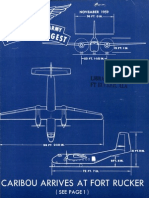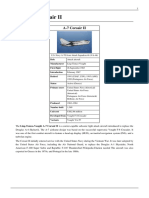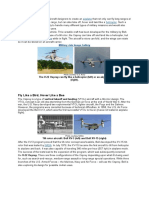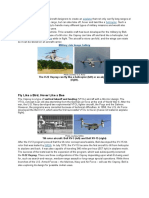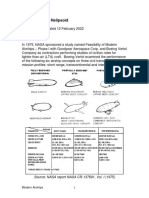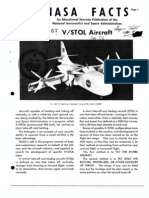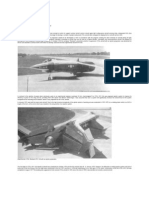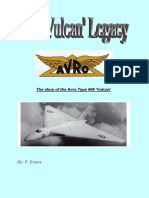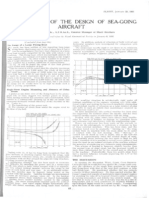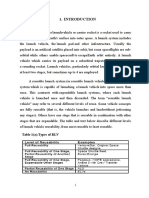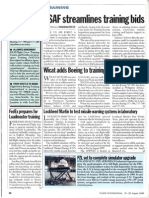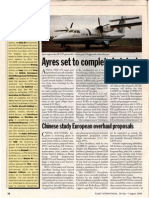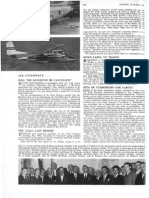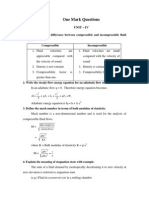1961 - 0077 BR 945
1961 - 0077 BR 945
Uploaded by
dagger21Copyright:
Available Formats
1961 - 0077 BR 945
1961 - 0077 BR 945
Uploaded by
dagger21Original Description:
Original Title
Copyright
Available Formats
Share this document
Did you find this document useful?
Is this content inappropriate?
Copyright:
Available Formats
1961 - 0077 BR 945
1961 - 0077 BR 945
Uploaded by
dagger21Copyright:
Available Formats
FLIGHT, 20 January 1961
6.OOO -
4.OOO -
2.OOO "
75
2OO 4OO 6OO 600 1,000^200 1,400 16OO
MILES
A pleasing study of the Max Holste Super
Broussard, which has completed a major part
of its test-flying since it flew last July
t
i 0
2OO
5O
4OO
1OO
A
, FEET
15O
s
y
6OO
t
2OO
8OO
i
25O
S in
/ 34
ipbo
3OO
5m
ft
35O
-15m,49 ft
METRES
2OO 15O 1OO
METRES
Makers' performance curves for the Breguet 945. Above, left, is a payhad/range plot: A, manoeuvring factor 2.5; 6, manoeuvring factor 3.5;
C, take-off weight 10 tonnes (22,0501b); D, take-off weight 11 tonnes. The lower diagrams are for take-off (left) and landing, fetters A and
B respectively representing sea level at 15C and lfiOOm (3J80H) altitude at 40C
sive windows and some illustrations have shown an armed version
with heavy-calibre machine guns mounted in the nose and in
doorways, as well as rocket pods and missiles.
The graphs above clearly illustrate the remarkable slow-flying
performance of this machine. It can fly at 45kt and make turns
of as little as 80yd radiussuch performance has indeed already
been demonstrated by the prototype 940. Breguet claim with some
justification that the performance of this series of blown-wing
transports is equivalent to that of presently available cargo heli-
copters. They also claim four safety factors in the basic layout.
The failure of one engine on take-off has no asymmetric-power
effect;* and less than half power is lost because the propellers
SIKORSKY'S UTV
THE above account of French STOL aeroplanes is illustrative
-*- of the manner in which such machines are encroaching upon
the domain of the helicopter. Aware of this fact, Sikorsky are
making a sustained effort to produce better helicopters. Around
the formula of a single, multi-blade lifting rotor, shaft-driven by
turbines, they are developing a series of excellent vehicles, most
of which have an amphibious hull of flying-boat form. Their lift
and propulsion systems have been used as the basis for a series
of "cranes," intended to lift and place loads over relatively short
rangespossibly no more than a few yards.
Flight experience has already been gained with the S-60 crane,
derived from the S-56. Its turbine counterpart is the impressive
S-64, projected with twin GE T64 or P & W JTF-12 engines.
Now Sikorsky have announced a smaller crane, to which we
referred in a leading article last week: the UTV, or Universal
Tactical Vehicle.
In general, the members of United Aircraft Corp are conserva-
tive, and Sikorsky's choice of so pretentious a name for this new
crane suggests that they feel it should be the right answer for some
years to come. Its dynamic components are those of the US Navy's
HSS-2, the combat counterpart of the S-61L illustrated on page 33
of our January 6 issue. Twin GE T58-6 engines, each rated at
1,OM) s.h.p., drive a five-blade 62ft main rotor; eross weight of
the HSS-2 is classified, but the S-61L weighs 18,7001b.
In their 1961 calendar Sikorsky depict the UTV in several roles.
Some of these require the powerful winch in line with the rotor
axis, and in all cases the co-pilot can swivel his seat through
180 to face a duplicate set of flight controls and rear-facing
windows. The suggested missions are; passenger or troop trans-
put, with approximately 20 seats; ASW, carrying a pod housing
a sonar, weanons and two operators; cargo transport, on a
.suspended pallet; emergency dispensary, the pod housing a field
hospital; missile transport, tactical weapons being carried on
:neir launchers; mobile machine shop (a role in which the UTV's
itting ability might be useful in rescue or salvage operations);
"capons transport; rescue, survivors from any catastrophe being
mched directly into a medical capsule; mine countermeasures,
'tn a special sweeping pod; tanker, with a palletized bag; power
work more efficiently under the lower load. The descent gradient
during the approach can be up to four times steeper than that of a
conventional aircraft, rendering obstacle clearance much easier.
Full power can be very rapidly applied in reverse thrust to shorten
the landing run, even on slippery ground. Because each approach
is made with power, an overshoot can be more quickly initiated
and involves only a change in propeller pitch. The flaps can be
immediately retracted to reduce drag.
The 945 can also operate as a conventional aircraft, without full
slipstream deflection, and its permissible gross weight can then
be increased to 26,4001b, with consequent improvement in payload
and range.
package, carrying an electric generator; and radar outpost, built
up from integrated pods. Tantalizingly few details of the UTV
are available, but indicative of its lifting ability is the fact that the
useful load of the S-61L is 9,4301b out of a gross weight of
18,7001b. Sikorsky may price the UTV at about $600,000.
You might also like
- Aircraft Engine Manual Jt8dDocument4 pagesAircraft Engine Manual Jt8dAli88_azizi20% (10)
- VSTOL History and DevelopmentDocument83 pagesVSTOL History and DevelopmentPrateek JainNo ratings yet
- CVF Ski-Jump Ramp Profile Optimisation For F-35B 3324 - COLOURDocument7 pagesCVF Ski-Jump Ramp Profile Optimisation For F-35B 3324 - COLOURskylancer-3441No ratings yet
- Unconventional Aircraft ConceptsDocument172 pagesUnconventional Aircraft ConceptsJack Azad100% (4)
- Turbofan & TurbopropDocument47 pagesTurbofan & TurbopropHamza ShahidNo ratings yet
- Ski Jump Info CVF & Others Testing 28 May 2014 pp163Document163 pagesSki Jump Info CVF & Others Testing 28 May 2014 pp163SpazSinbad2100% (1)
- The Aircraft Engineer: W B.H.P. B.H.PDocument1 pageThe Aircraft Engineer: W B.H.P. B.H.PMark Evan SalutinNo ratings yet
- 8005Document12 pages8005charangudlaNo ratings yet
- Combat Ready: Flight InternationalDocument1 pageCombat Ready: Flight InternationalDrSomnath999No ratings yet
- Megalifter Hybrid Aircraft R1 Converted CompressedDocument11 pagesMegalifter Hybrid Aircraft R1 Converted CompressedTasko SadikovicNo ratings yet
- Aircraft 7Document2 pagesAircraft 7panNo ratings yet
- Federation ArielDocument1 pageFederation Arielphilppuk6101No ratings yet
- Army Aviation Digest - Nov 1959Document40 pagesArmy Aviation Digest - Nov 1959Aviation/Space History Library100% (3)
- % For The Service Arena: The British Aircraft IndustryDocument1 page% For The Service Arena: The British Aircraft Industryseafire47No ratings yet
- Ski Jump Information F-35BDocument88 pagesSki Jump Information F-35BSpazSinbad2100% (1)
- Helicopters Indian FinalistsDocument3 pagesHelicopters Indian FinalistsBharat TailorNo ratings yet
- Spitfire Tailplane Protection and Spinning TrialsDocument9 pagesSpitfire Tailplane Protection and Spinning TrialsSesquipedaliacNo ratings yet
- Ins VikramadityaDocument17 pagesIns VikramadityaaadinaravNo ratings yet
- Ilyushin Il - 78Document16 pagesIlyushin Il - 78Anton MihailovNo ratings yet
- Carrying The Flag - HMS Invincible and HarriersDocument5 pagesCarrying The Flag - HMS Invincible and HarrierspennichangeNo ratings yet
- Helistat Airship Drone HybridDocument30 pagesHelistat Airship Drone HybridLolNo ratings yet
- Northrop N-63 Convoy Fighter: The Naval VTOL Turboprop Tailsitter Project of 1950From EverandNorthrop N-63 Convoy Fighter: The Naval VTOL Turboprop Tailsitter Project of 1950Rating: 5 out of 5 stars5/5 (2)
- LTV A-7 CorsairDocument18 pagesLTV A-7 CorsairTimothy Teo100% (3)
- Aircraft 9Document2 pagesAircraft 9panNo ratings yet
- Amphibious AircraftDocument11 pagesAmphibious Aircraftkiran gosuNo ratings yet
- Airplane Helicopter: Fly Like A Bird, Hover Like A BeeDocument6 pagesAirplane Helicopter: Fly Like A Bird, Hover Like A BeeRajeev AiyappanNo ratings yet
- Airplane Helicopter: Fly Like A Bird, Hover Like A BeeDocument6 pagesAirplane Helicopter: Fly Like A Bird, Hover Like A BeeRajeev AiyappanNo ratings yet
- Reusser C. Modern Ship Engineering, Design and Operations, 2021Document87 pagesReusser C. Modern Ship Engineering, Design and Operations, 2021Xue Feng DuNo ratings yet
- Aircraft 29Document2 pagesAircraft 29panNo ratings yet
- N.a.C.a. Aircraft Circular No.1 - 1926-03 - Liore-Olivier Airplane Type 12 Night-Bomber or Type 20 CommercialDocument10 pagesN.a.C.a. Aircraft Circular No.1 - 1926-03 - Liore-Olivier Airplane Type 12 Night-Bomber or Type 20 CommercialPiero CaprettiNo ratings yet
- V/Stol Concepts in The United States - Past, Present, and FutureDocument48 pagesV/Stol Concepts in The United States - Past, Present, and FutureTasko SadikovicNo ratings yet
- The Lockheed ConstellationDocument136 pagesThe Lockheed ConstellationAviation Library100% (4)
- British Aerospace Hawk: Armed Light Attack and Multi-Combat Fighter TrainerFrom EverandBritish Aerospace Hawk: Armed Light Attack and Multi-Combat Fighter TrainerNo ratings yet
- Lcu FDocument5 pagesLcu Fwildfire142No ratings yet
- Boeing-Vertol HelipsoidDocument8 pagesBoeing-Vertol HelipsoidTasko SadikovicNo ratings yet
- NASA Facts VSTOL AircraftDocument8 pagesNASA Facts VSTOL AircraftBob AndrepontNo ratings yet
- Rockwell XFVDocument5 pagesRockwell XFVdwaynefields100% (1)
- Italian VSTOL Concepts of The Twentieth CenturyDocument46 pagesItalian VSTOL Concepts of The Twentieth CenturyHarold_Godwinson100% (2)
- Book Sent To Publishers On The Vulcan B.1-2 Production, History and SQN List (Updated) PDFDocument63 pagesBook Sent To Publishers On The Vulcan B.1-2 Production, History and SQN List (Updated) PDFPhillip EvansNo ratings yet
- Thrust Vectoring - Technical SeminarDocument20 pagesThrust Vectoring - Technical SeminarNithish Jain100% (1)
- Military Parade 1Document92 pagesMilitary Parade 1Dragovic Slobodan100% (1)
- CL-1 Introduction To VSTOLDocument11 pagesCL-1 Introduction To VSTOLMohit GargNo ratings yet
- (Aircraft Profile 084) - Short Empire Boats PDFDocument16 pages(Aircraft Profile 084) - Short Empire Boats PDFPeter de Clerck100% (2)
- Design and Structural Analyses of A ReciprocatingDocument15 pagesDesign and Structural Analyses of A ReciprocatingangelNo ratings yet
- Historical Overview of v-STOL Aircraft TechnologyDocument20 pagesHistorical Overview of v-STOL Aircraft TechnologyMarioNo ratings yet
- Aircraft Review - Sikorsky SH-3 Sea King (S-61) by Virtavia and Dawson Design - Helicopter Reviews - X-Plane Reviews PDFDocument23 pagesAircraft Review - Sikorsky SH-3 Sea King (S-61) by Virtavia and Dawson Design - Helicopter Reviews - X-Plane Reviews PDFchelcarNo ratings yet
- Naval Aviation News - May 1950Document44 pagesNaval Aviation News - May 1950CAP History LibraryNo ratings yet
- Air Liaison Marine Craft: Viluers HayDocument1 pageAir Liaison Marine Craft: Viluers Hayseafire47No ratings yet
- Variable-Pitch Propeller: Aircraft Ships See Also References External LinksDocument5 pagesVariable-Pitch Propeller: Aircraft Ships See Also References External LinksBenjamin RamirezNo ratings yet
- Some Aspects of The Design of Seagoing Aircraft Part 2Document4 pagesSome Aspects of The Design of Seagoing Aircraft Part 2Mark Evan SalutinNo ratings yet
- Design and Development of Reusable Launch VehicleDocument63 pagesDesign and Development of Reusable Launch VehicleRaghav Kumar PatelNo ratings yet
- AJ10-133 Specs GE ExcerptDocument50 pagesAJ10-133 Specs GE ExcerptStrawichDanielNo ratings yet
- Schleicher ASW 20: ConstructionDocument4 pagesSchleicher ASW 20: ConstructionstfNo ratings yet
- ApacheDocument22 pagesApacheAbhimanyu Singh100% (1)
- FlightGlobal - Vosper Harrier CarrierDocument1 pageFlightGlobal - Vosper Harrier CarrierAwesomeDeliteNo ratings yet
- 89232main - TF 2004 13 DFRC PDFDocument4 pages89232main - TF 2004 13 DFRC PDFOre Ulil DesuNo ratings yet
- Federation Ship Recognition ManualDocument129 pagesFederation Ship Recognition ManualCraig Fenion91% (22)
- Catapult SystemDocument7 pagesCatapult Systemandrew munyiva0% (1)
- Ii Iii Ii: - Li Imi MDocument1 pageIi Iii Ii: - Li Imi MwabeebdNo ratings yet
- Amphibious Aircrafts Sample BookDocument115 pagesAmphibious Aircrafts Sample BookRudolf Pinochet100% (1)
- Air Taxi Business ModelDocument62 pagesAir Taxi Business Modeldagger210% (1)
- Have Doughnut - USAF MiG-21 ExploitationDocument310 pagesHave Doughnut - USAF MiG-21 ExploitationTDRSS100% (2)
- Have Nose Iraqi Mig-29 of The Us Air Force: Contributing Author Rob Young, Nasic HistorianDocument1 pageHave Nose Iraqi Mig-29 of The Us Air Force: Contributing Author Rob Young, Nasic Historiandagger21No ratings yet
- Grumman CorporationDocument135 pagesGrumman Corporationdagger21No ratings yet
- Let's Future in Hands of Creditor: Australia's Air 87 Competition Slips To MarchDocument1 pageLet's Future in Hands of Creditor: Australia's Air 87 Competition Slips To Marchdagger21No ratings yet
- Ayres Lets Czech Republic For Fedex Loadmaster Production: Fairchild Lines Up Envoy 3 For June CertificationDocument1 pageAyres Lets Czech Republic For Fedex Loadmaster Production: Fairchild Lines Up Envoy 3 For June Certificationdagger21No ratings yet
- New A340 Runs Into Exit Row: Canada Begins Maritime Helicopter Project To Replace Sikorsky CH-124Document1 pageNew A340 Runs Into Exit Row: Canada Begins Maritime Helicopter Project To Replace Sikorsky CH-124dagger21No ratings yet
- Florida West International Airways (RF) (FWL)Document1 pageFlorida West International Airways (RF) (FWL)dagger21No ratings yet
- USAF Streamlines Training Bids: Wicat Adds Boeing To Training Device PortfolioDocument1 pageUSAF Streamlines Training Bids: Wicat Adds Boeing To Training Device Portfoliodagger21No ratings yet
- Fedex Express in Talks To Acquire Continental Atrs: Australia Reveals Electromagnetic Pulse WeaponDocument1 pageFedex Express in Talks To Acquire Continental Atrs: Australia Reveals Electromagnetic Pulse Weapondagger21No ratings yet
- Florida West International Airways (RF) (FWL)Document1 pageFlorida West International Airways (RF) (FWL)dagger21No ratings yet
- Directory: World Airliners: OptionDocument1 pageDirectory: World Airliners: Optiondagger21No ratings yet
- Assignment 2 NAMEDocument1 pageAssignment 2 NAMEdagger21No ratings yet
- Ayres Set To Complete Let Deal: Chinese Study European Overhaul ProposalsDocument1 pageAyres Set To Complete Let Deal: Chinese Study European Overhaul Proposalsdagger21No ratings yet
- Ayres Aircraft LoadmasterDocument1 pageAyres Aircraft Loadmasterdagger21No ratings yet
- Down Fares, Up Traffic: Air Commerce ... Will The Rotodyne Be Cancelled?Document1 pageDown Fares, Up Traffic: Air Commerce ... Will The Rotodyne Be Cancelled?dagger21No ratings yet
- Student Work BookDocument119 pagesStudent Work Bookdagger21No ratings yet
- Date Pilot Acs N LocationDocument6 pagesDate Pilot Acs N Locationdagger21No ratings yet
- Breguet 94O and 941: Initiation of Important STOL ProgrammeDocument1 pageBreguet 94O and 941: Initiation of Important STOL Programmedagger21No ratings yet
- The History of Space ExplorationDocument5 pagesThe History of Space ExplorationJefferson CrespoNo ratings yet
- Interview Test QuestionDocument9 pagesInterview Test QuestionshahsxNo ratings yet
- Col. R. Patenaude - Prompt Global Strike Update, 2005.Document12 pagesCol. R. Patenaude - Prompt Global Strike Update, 2005.2495MPnetNo ratings yet
- The Design and Fabrication of Top Secret - La Mouette'S Rigid Hang GliderDocument5 pagesThe Design and Fabrication of Top Secret - La Mouette'S Rigid Hang GliderORLANDO CASTILLONo ratings yet
- ICW 04) AeropacDocument19 pagesICW 04) AeropacjjaavvmmNo ratings yet
- Bottle Rocket Calculations: Example Using 70 Psi and 350 ML of WaterDocument11 pagesBottle Rocket Calculations: Example Using 70 Psi and 350 ML of WaterMasha MusthafaNo ratings yet
- A320 Limitations PDFDocument6 pagesA320 Limitations PDFa320neoNo ratings yet
- (English) What I Learned From Going Blind in Space - Chris Hadfield (DownSub - Com)Document15 pages(English) What I Learned From Going Blind in Space - Chris Hadfield (DownSub - Com)Maulana Yazid Al AnnuriNo ratings yet
- Optimal Supersonic Intake Design For AirDocument17 pagesOptimal Supersonic Intake Design For AirMihai ClaudiuNo ratings yet
- NASA Investigation Board Report On The Initial Flight Anomalies of Skylab 1 May 16, 1973Document150 pagesNASA Investigation Board Report On The Initial Flight Anomalies of Skylab 1 May 16, 1973Bob AndrepontNo ratings yet
- Rocket Propulsion and Spaceflight DynamicsDocument11 pagesRocket Propulsion and Spaceflight DynamicsUday Reddy0% (1)
- How To Read A PilotDocument7 pagesHow To Read A PilotEvren ErdemNo ratings yet
- Propeller PresentationDocument27 pagesPropeller PresentationIkhwan Hadi100% (1)
- High School Aviation Curriculum GuideDocument69 pagesHigh School Aviation Curriculum Guideairbuk doeingNo ratings yet
- Raz lm27 Voyagersinspace CLR PDFDocument9 pagesRaz lm27 Voyagersinspace CLR PDFRachelle Ann MarianoNo ratings yet
- Lesson 09 - Gas Turbines IDocument25 pagesLesson 09 - Gas Turbines ISohaib Arshad100% (3)
- Pages From COMPRESSIBLE FLOW PDFDocument8 pagesPages From COMPRESSIBLE FLOW PDFashoku2No ratings yet
- P ECT: VSSC LibraryDocument34 pagesP ECT: VSSC Librarysudhiruday31No ratings yet
- General Info and LimitationsDocument7 pagesGeneral Info and LimitationsBogdan TudosieNo ratings yet
- List of EPAS Acronyms and Definitions - For PublicationDocument15 pagesList of EPAS Acronyms and Definitions - For Publicationbykr aknNo ratings yet
- 1 1 1 P AerospaceevolutionDocument4 pages1 1 1 P Aerospaceevolutionapi-326094851No ratings yet
- Estes Model Rocket EnginesDocument1 pageEstes Model Rocket Enginesaaguiar1No ratings yet
- Icao Annexes and Others PDFDocument7 pagesIcao Annexes and Others PDFRealyn LabaynaNo ratings yet
- The Planetary and Lunar Ephemeris DE 421: William M. Folkner, James G. Williams, and Dale H. BoggsDocument34 pagesThe Planetary and Lunar Ephemeris DE 421: William M. Folkner, James G. Williams, and Dale H. BoggsMarshall EubanksNo ratings yet
- Comparison and Development Analysis of F119-PW-100 & F135-PW-100Document5 pagesComparison and Development Analysis of F119-PW-100 & F135-PW-100luna maoNo ratings yet
- APJ Abdul Kalam Success StoryDocument1 pageAPJ Abdul Kalam Success StorySanjaiNo ratings yet
- Astro PDFDocument80 pagesAstro PDFnil4No ratings yet












